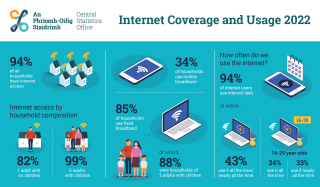Internet Coverage and Usage in Ireland 2022

A recent publication, Internet Coverage and Usage in Ireland 2022, from the Central Statistics Office (CSO) found that whilst one in every fourteen have never used the internet, more than four in ten of those that use the internet every day are almost constantly online.
Arguably one of the biggest changes brought on by the Covid-19 pandemic has been to working practices. With many adults still working from home and children using the internet as a learning tool, good quality, affordable, reliable internet connection is now a necessity, not a luxury. The CSO notes that "students were the most frequent users of the internet in 2022 with 97% going online at least several times a day". It is an essential economic, social, and educational inclusion tool that enables people to fully participate in society and remain connected and informed. It will be important to ensure ease and equality of access so that already disadvantaged or marginalised groups do not fall further behind. There continue to be areas in (particularly rural) Ireland that continue to be disadvantaged by way of limited or poor access. The digital divide will further exacerbate educational disadvantage in areas with poor connectivity.
Internet connectivity in 2022 stood at 94 per cent, an increase of one percentage point from 2021. Almost every household with children is connected to the internet compared to 82 per cent of adult only households.
Fixed broadband connection is the most used, accounting for 85 per cent of households. Households in Dublin and the Mid-East continue to outpace the rest of the country for access to fixed broadband (with 92 per cent and 86 per cent connectivity respectively), while the Border and Midlands Regions fare the worst (with 77 per cent and 79 per cent respectively). Among households who did not have internet access, the main reasons for not having it were that it was not needed (56 per cent), followed by a lack of skills (32 per cent), prohibitive cost of access and high equipment costs (10 per cent and 7 per cent) and a further 2 per cent citing security or privacy concerns. Seven per cent also reported the lack of availability of broadband internet as a factor.
At a European level, in 2022, Ireland ranks 5th in the EU Digital Economy and Society Index (DESI). Between 2017 and 2022, Ireland’s average yearly relative growth of its DESI score is approximately 8.5 per cent, one of the highest in the EU.
The Index reports that fixed, very high-capacity network (VHCN) coverage has increased from 83 per cent in 2021 to 89 per cent in 2022 after a low of 35 per cent in 2020. This compares to an EU average of 70 per cent. However, despite this, in terms of connectivity, the take up of at least 100Mbps fixed broadband is only 37 per cent compared to the EU average of 41 per cent.
Ireland performs above the EU average in advanced digital skills (for example, for the indicators on ICT specialists, female ICT specialists and ICT graduates) and there has been an increase in the basic digital skills of the population. Ireland’s use of the internet is broadly in line with the European average. Our use of the internet points to a society that is moving away from personal social interaction, towards virtual engagement with others. According to the DESI, Ireland scores a perfect 100 for digital public services for businesses.
National Broadband Plan Broadband, particularly for rural areas, is essential if Ireland is to keep pace with globalisation while also ensuring balanced rural development. If the change to working from home becomes permanent for many, location will no longer be an issue allowing many to relocate from expensive urban centres to more rural locations. Training and up-skilling will be vital in order to ensure access and protect users online as the digital world changes and evolves.